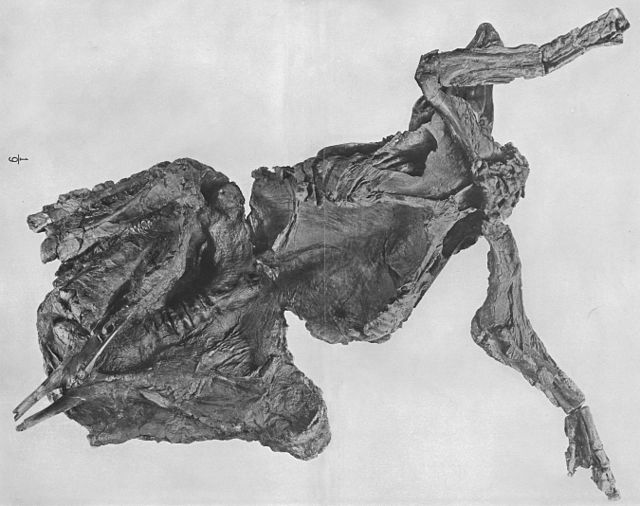Edmontosaurus mummy AMNH 5060
The Edmontosaurus mummy AMNH 5060 is an exceptionally well-preserved fossil of a dinosaur in the collection of the American Museum of Natural History (AMNH). Discovered in 1908 in the United States near Lusk, Wyoming, it was the first dinosaur specimen found to include a skeleton encased in skin impressions from large parts of the body. It is ascribed to the species Edmontosaurus annectens, a hadrosaurid. The mummy was found by fossil hunter Charles Hazelius Sternberg and his three sons in the Lance Formation. Although Sternberg was working under contract to the British Museum of Natural History, Henry Fairfield Osborn of the AMNH managed to secure the mummy. Osborn described the fossil in detail in 1912, coining the name "dinosaur mummy" for it—several dinosaur mummies of similar preservation have been discovered since then. This specimen has considerably influenced the scientific conception of hadrosaurids. Skin impressions found in between the fingers were once interpreted as interdigital webbing, bolstering the now-rejected perception of hadrosaurids as aquatic animals, a hypothesis that remained unchallenged until 1964. Today, the mummy is considered one of the most important fossils of the AMNH.

The Edmontosaurus mummy AMNH 5060 at the American Museum of Natural History, New York, in top view
Only known photograph of the mummy's excavation, Wyoming, 1908
The mummy on exhibit in the American Museum of Natural History (2008)
Skin impression of the shoulder region, showing the smaller "ground tubercles" and clusters of larger "pavement tubercles"
Edmontosaurus, with the second species often colloquially and historically known as Anatosaurus or Anatotitan, is a genus of hadrosaurid (duck-billed) dinosaur. It contains two known species: Edmontosaurus regalis and Edmontosaurus annectens. Fossils of E. regalis have been found in rocks of western North America that date from the late Campanian age of the Cretaceous period 73 million years ago, while those of E. annectens were found in the same geographic region from rocks dated to the end of the Maastrichtian age, 66 million years ago. Edmontosaurus was one of the last non-avian dinosaurs to ever exist, and lived alongside dinosaurs like Triceratops, Tyrannosaurus, Ankylosaurus, and Pachycephalosaurus shortly before the Cretaceous–Paleogene extinction event.
Skeletal restoration of the E. annectens (then Claosaurus) holotype, by Othniel Charles Marsh
E. annectens paratype YPM 2182 at the Yale University Museum, the first nearly complete dinosaur skeleton mounted in the United States.
AMNH 5060: an E. annectens with skin impressions
Specimen CMNFV 8399, holotype of E. edmontoni, now thought to be a young E. regalis.








